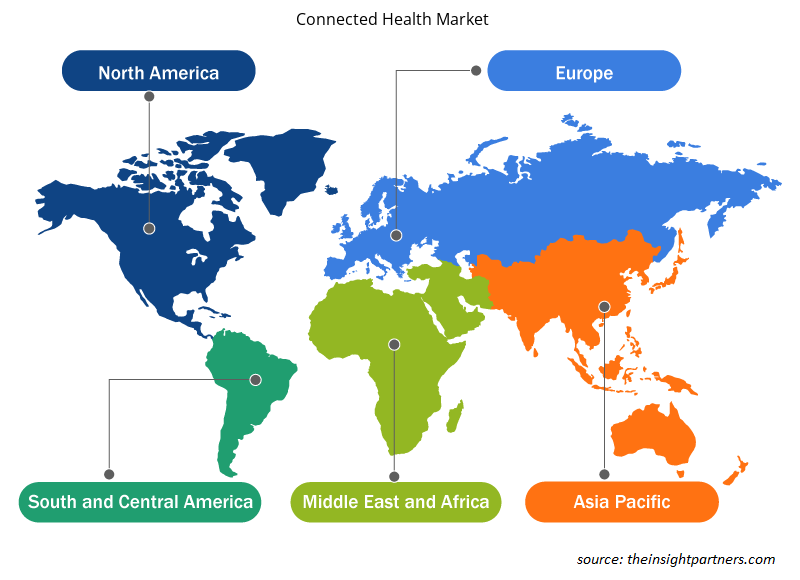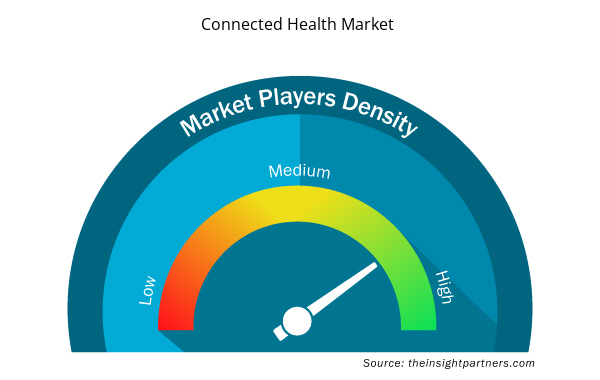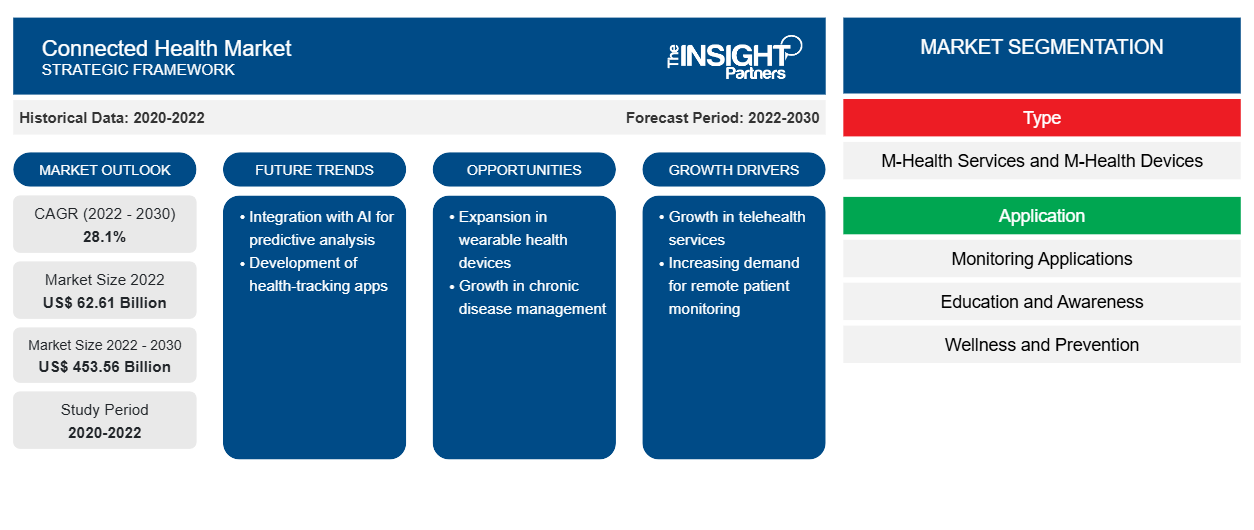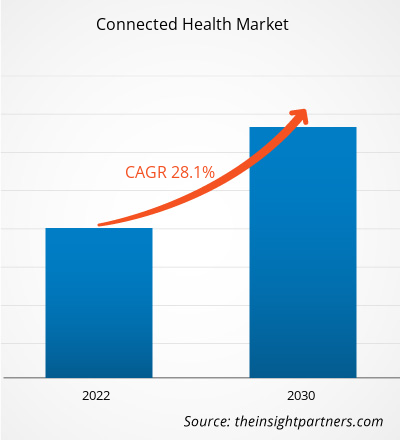[تقرير بحثي] تم تقييم حجم سوق الصحة المتصلة بـ 62.61 مليار دولار أمريكي في عام 2022 ومن المتوقع أن يصل إلى 453.56 مليار دولار أمريكي بحلول عام 2030. ومن المتوقع أن يسجل السوق معدل نمو سنوي مركب بنسبة 28.1٪ من عام 2022 إلى عام 2030.
رؤى السوق ووجهة نظر المحلل:
إن العديد من مؤسسات الرعاية الصحية تجد طرقًا جديدة وأكثر كفاءة لتحسين جودة العلاج الذي تقدمه بسبب الطلب على القيمة والبيئة التنافسية المتزايدة. إن تمكين الاتصال بين المريض ومقدم الخدمة "في أي وقت وفي أي مكان" هو أحد الطرق لجعل الخدمات أكثر سهولة وأقل تكلفة. التشخيص عن بعد والعلاج والمراقبة والاتصال كلها ممكنة مع الصحة المتصلة ( cHealth )، وهو نظام متكامل لتقديم الرعاية مدعوم بالتكنولوجيا.إن عوامل مثل التبني المتزايد للصحة الرقمية وبرامج الشيخوخة الذكية من قبل منظمة الصحة العالمية تعمل على تعزيز نمو سوق الصحة المتصلة .
محركات السوق:
تساهم الصحة الرقمية في جعل ممارسات الرعاية الصحية أكثر قابلية للإدارة وأسهل من خلال جمع البيانات المتعلقة بالصحة أو معلومات الرعاية الصحية وتقديم الخدمات للمرضى. تعد تقنية الصحة المتصلة أداة تدعم العلاجات وإدارة الأمراض المزمنة ومراقبة الأمراض. يتزايد معدل الإصابة بالأمراض المزمنة، بما في ذلك أمراض القلب والسكري والسرطان، نتيجة لتغير أنماط الحياة. بالنسبة للمرضى الذين يعانون من أمراض غير معدية ويحتاجون إلى مراقبة مستمرة، تلعب الصحة الرقمية دورًا رئيسيًا في تلبية هذه المتطلبات. في كثير من الحالات، تغيرت إدارة الأمراض المزمنة نتيجة للمراقبة عن بعد عبر تقنيات الصحة المتنقلة وتقييم البيانات عبر الأدوات الرقمية والأجهزة القابلة للارتداء . بالإضافة إلى تحويل التركيز من الرعاية الحادة والتفاعلية إلى الرعاية الاستباقية والوقائية، غيرت الصحة المتصلة الطريقة التي يتعامل بها المرضى مع مقدمي الرعاية الصحية والأنظمة القائمة على الرعاية الصحية. ساعد التطوير المتزايد وتنفيذ التقنيات التي تجعل الرعاية الصحية الرقمية ميسورة التكلفة ومريحة في اعتمادها.
إن تكنولوجيا المعلومات المتزايدة تؤدي إلى زيادة التبني في قطاع الصحة مما يساعد على نمو الصحة المتصلة بسرعة في جميع أنحاء العالم. تحت mHealth ، تلعب الأجهزة مثل الهواتف المحمولة وأجهزة الكمبيوتر المحمولة والأجهزة اللوحية دورًا رئيسيًا في زيادة التغطية الصحية. نظرًا لتكنولوجيا الهاتف المحمول المتزايدة، تتجه الحكومات والمنظمات الأخرى إلى الأجهزة المحمولة لتحسين الإنتاجية الفعالة والتركيز أيضًا على ربط قوتها لاستخدام بيانات الصحة الحالية في الوقت المناسب. يسمح التطور السريع للتكنولوجيا المتقدمة بزيادة مشاركة معلومات البيانات بين الأنظمة الإلكترونية. يساعد أمان البيانات الصحية المتزايد المستخدمين على الحصول على بيانات دقيقة ويوفر لصناع القرار تحسين القدرة على اتخاذ القرارات الحاسمة. وبالتالي، نظرًا لسهولة الوصول والتنوع الواسع للتطبيقات، يمكن لعدد كبير من الأشخاص استخدام الصحة الرقمية، مما من المرجح أن يعزز نمو سوق الصحة المتصلة.
من المتوقع أن يؤدي تبني إنترنت الأشياء الطبية ( IoMT ) إلى ظهور اتجاهات جديدة في سوق الرعاية الصحية المتصلة في السنوات القادمة. ومع ذلك، فإن العديد من مؤسسات الرعاية الصحية تفرض مخاطر تؤدي إلى خروقات البيانات الصحية الشخصية ولا تقدم إرشادات لحماية المعلومات الصحية الشخصية الإلكترونية. وبالتالي، فإن التهديدات المتزايدة لاستخدام هذه الخدمات تعزز بشكل متناسب أمن البيانات الصحية الذي يقيد سوق الرعاية الصحية المتصلة.
قم بتخصيص هذا التقرير ليناسب متطلباتك
ستحصل على تخصيص لأي تقرير - مجانًا - بما في ذلك أجزاء من هذا التقرير، أو تحليل على مستوى الدولة، وحزمة بيانات Excel، بالإضافة إلى الاستفادة من العروض والخصومات الرائعة للشركات الناشئة والجامعات
- احصل على أهم اتجاهات السوق الرئيسية لهذا التقرير.ستتضمن هذه العينة المجانية تحليلاً للبيانات، بدءًا من اتجاهات السوق وحتى التقديرات والتوقعات.
تقسيم التقرير ونطاقه:
تم إجراء "تحليل سوق الصحة المتصلة" من خلال النظر في القطاعات التالية: النوع والتطبيق والمستخدم النهائي. حسب النوع، يتم تقسيم السوق إلى خدمات الصحة المحمولة وأجهزة الصحة المحمولة. حسب التطبيق، يتم تقسيم السوق إلى تطبيقات المراقبة والتشخيص والعلاج وإدارة الرعاية الصحية والعافية والوقاية وغيرها. بناءً على المستخدم النهائي، يتم تصنيف السوق إلى المستشفيات والعيادات ومراقبة المنزل وغيرها.
التحليل القطاعي:
ينقسم سوق الصحة المتصلة، حسب النوع، إلى خدمات الصحة عبر الهاتف المحمول وأجهزة الصحة عبر الهاتف المحمول. وقد استحوذ قطاع خدمات الصحة عبر الهاتف المحمول على حصة أكبر من السوق في عام 2022؛ ومع ذلك، من المرجح أن يسجل قطاع أجهزة الصحة عبر الهاتف المحمول معدل نمو سنوي مركب أعلى في سوق الصحة المتصلة خلال الفترة 2022-2030. وبدلاً من مراقبة المرضى داخليًا في المرافق الطبية، تركز الصحة المتصلة بشكل أكبر على نقل البيانات عن بُعد وتوفير خدمات الرعاية الصحية المناسبة في المنزل. وبصرف النظر عن القدرة على تقديم الرعاية الصحية عن بُعد، فإن أكبر تقدم في مجال الصحة المتصلة هو البيانات الضخمة المتاحة. وبمساعدة خدمات الصحة المتصلة، يمكن للأطباء اتخاذ قرارات أكثر استنارة وتوفير علاج استباقي يعطي الأولوية لاحتياجات المرضى.
من حيث التطبيق، يتم تقسيم سوق الصحة المتصلة إلى تطبيقات المراقبة والتشخيص والعلاج وإدارة الرعاية الصحية والعافية والوقاية وغيرها. احتل قطاع تطبيقات المراقبة الحصة الأكبر من السوق في عام 2022؛ ومع ذلك، من المرجح أن يسجل قطاع التشخيص والعلاج أعلى معدل نمو سنوي مركب في سوق الصحة المتصلة خلال الفترة 2022-2030. تعمل أنظمة المراقبة عن بعد المدمجة مع إنترنت الأشياء (IoT) وأجهزة الاستشعار الرقمية وأدوات البيانات الضخمة على تحسين الوصول إلى المرضى، مما فتح فرصًا جديدة تركز على تحسين تقديم خدمات الرعاية الصحية. زاد دمج هذه الأنظمة بشكل كبير خلال أزمة كوفيد-19. توفر أنظمة مراقبة الصحة عن بعد (HRMS) مزايا مختلفة، بما في ذلك تقليل عبء المرضى في المراكز الصحية والمستشفيات.
من حيث المستخدم النهائي، يتم تقسيم سوق الرعاية الصحية المتصلة إلى المستشفيات والعيادات، ومراقبة المنزل، وغيرها. في عام 2022، هيمنت شريحة المستشفيات والعيادات على حصة سوق الرعاية الصحية المتصلة. ومع ذلك، من المتوقع أن تسجل شريحة مراقبة المنزل أعلى معدل نمو سنوي مركب خلال الفترة 2022-2030. وفقًا لشركة OAE Publishing Inc.، في عام 2021، نفذت ما يقرب من نصف المستشفيات الأمريكية شكلًا من أشكال الرعاية الصحية المتصلة لمراقبة المرضى عن بُعد، وأدرجت حوالي 80٪ من الدول الأوروبية خدمات الطب عن بعد في خدمات الرعاية الصحية الخاصة بها.
التحليل الإقليمي:
ينقسم نطاق تقرير سوق الصحة المتصلة بشكل أساسي إلى أمريكا الشمالية (الولايات المتحدة وكندا والمكسيك) وأوروبا (إسبانيا والمملكة المتحدة وألمانيا وفرنسا وإيطاليا وبقية أوروبا) وآسيا والمحيط الهادئ (كوريا الجنوبية والصين والهند واليابان وأستراليا وبقية آسيا والمحيط الهادئ) والشرق الأوسط وأفريقيا (جنوب أفريقيا والمملكة العربية السعودية والإمارات العربية المتحدة وبقية الشرق الأوسط وأفريقيا) وأمريكا الجنوبية والوسطى (البرازيل والأرجنتين وبقية أمريكا الجنوبية والوسطى).
من حيث الإيرادات، في عام 2022، هيمنت أمريكا الشمالية على حصة سوق الرعاية الصحية المتصلة. ومن المتوقع أن يسجل السوق في منطقة آسيا والمحيط الهادئ أعلى معدل نمو سنوي مركب خلال الفترة 2022-2030. ينمو السوق في منطقة آسيا والمحيط الهادئ بسبب الاستثمارات المتزايدة من اللاعبين الدوليين في الهند والصين، وتوسيع قواعد خدمات CRO، وتطوير البنية التحتية للرعاية الصحية، وتحسين الدعم الحكومي. علاوة على ذلك، قدمت شركة أبولو برنامج الرعاية المتصلة الشاملة في الهند في عام 2023. يستخدم هذا البرنامج تقنية الرعاية المتصلة المتطورة من أبولو. سيتم تنفيذ خدمات الرعاية المتصلة الشاملة من أبولو على مستوى البلاد، مما يتيح للفرق السريرية وموظفي التمريض الوصول إلى نظرة عامة شاملة ومحدثة للمريض في كل مرحلة من مراحل رعاية المريض، بما في ذلك الرعاية المنزلية، والرعاية بعد الجراحة، والرعاية الداخلية، وخدمات الطوارئ والإسعاف.
رؤى إقليمية حول سوق الرعاية الصحية المتصلة
لقد قام المحللون في Insight Partners بشرح الاتجاهات والعوامل الإقليمية المؤثرة على سوق الرعاية الصحية المتصلة طوال فترة التوقعات بشكل شامل. يناقش هذا القسم أيضًا قطاعات سوق الرعاية الصحية المتصلة والجغرافيا في جميع أنحاء أمريكا الشمالية وأوروبا ومنطقة آسيا والمحيط الهادئ والشرق الأوسط وأفريقيا وأمريكا الجنوبية والوسطى.

- احصل على البيانات الإقليمية المحددة لسوق الرعاية الصحية المتصلة
نطاق تقرير سوق الرعاية الصحية المتصلة
| سمة التقرير | تفاصيل |
|---|---|
| حجم السوق في عام 2022 | 62.61 مليار دولار أمريكي |
| حجم السوق بحلول عام 2030 | 453.56 مليار دولار أمريكي |
| معدل النمو السنوي المركب العالمي (2022 - 2030) | 28.1% |
| البيانات التاريخية | 2020-2022 |
| فترة التنبؤ | 2022-2030 |
| القطاعات المغطاة | حسب النوع
|
| المناطق والدول المغطاة | أمريكا الشمالية
|
| قادة السوق وملفات تعريف الشركات الرئيسية |
|
كثافة اللاعبين في السوق: فهم تأثيرها على ديناميكيات الأعمال
يشهد سوق الرعاية الصحية المتصلة نموًا سريعًا، مدفوعًا بالطلب المتزايد من المستخدم النهائي بسبب عوامل مثل تفضيلات المستهلكين المتطورة والتقدم التكنولوجي والوعي المتزايد بفوائد المنتج. ومع ارتفاع الطلب، تعمل الشركات على توسيع عروضها والابتكار لتلبية احتياجات المستهلكين والاستفادة من الاتجاهات الناشئة، مما يؤدي إلى زيادة نمو السوق.
تشير كثافة اللاعبين في السوق إلى توزيع الشركات أو المؤسسات العاملة في سوق أو صناعة معينة. وهي تشير إلى عدد المنافسين (اللاعبين في السوق) الموجودين في مساحة سوق معينة نسبة إلى حجمها أو قيمتها السوقية الإجمالية.
الشركات الرئيسية العاملة في سوق الصحة المتصلة هي:
- أثينا هيلث
- أجا ماتريكس
- المدرج الجوي
- شركة ألايف كور
- شركة أولسكريبتس للرعاية الصحية، ذ.م.م.
إخلاء المسؤولية : الشركات المذكورة أعلاه ليست مرتبة بأي ترتيب معين.

- احصل على نظرة عامة على أهم اللاعبين الرئيسيين في سوق الصحة المتصلة
المنافسة والشركات الرئيسية:
يركز تقرير سوق الرعاية الصحية المتصلة على اللاعبين البارزين في السوق مثل Athena Health وAgaMatrix وAirStrip وAliveCor Inc وAllscripts Healthcare LLC وApple Inc وNXGN Management LLC وCerner Corporation وCognizant وHoneywell International Inc. يمكن أن تساعد توقعات سوق الرعاية الصحية المتصلة أصحاب المصلحة في التخطيط لاستراتيجيات النمو الخاصة بهم. تركز هذه الشركات على التقنيات الجديدة وترقية المنتجات الحالية وتوسيع السوق لتلبية الطلب المتزايد من المستهلكين في جميع أنحاء العالم.
- في ديسمبر 2023، أبرمت GE HealthCare وAirStrip اتفاقية تسويق مشتركة. أصبحت GE HealthCare الموزع الحصري لحلول AirStrip Cardiology and Patient Monitoring في الولايات المتحدة، حيث تقدم تقنية تصور البيانات لأنظمة الرعاية الصحية.
- في يناير 2023، دخلت BioIntelliSense في شراكة مع care.ai لدمج بيانات BioIntelliSense عالية التردد لعلامات الحيوية والتنبيهات القائمة على الخوارزميات في سير عمل مراقبة المحيط في care.ai. تربط الشراكة بين القدرات التكميلية لهذه التقنيات التحويلية لتحسين رضا المرضى وتحسين العمليات السريرية ومعالجة التحديات الرئيسية التي تواجه القوى العاملة في مجال الرعاية الصحية المثقلة بالأعباء بشكل مباشر.
- التحليل التاريخي (سنتان)، السنة الأساسية، التوقعات (7 سنوات) مع معدل النمو السنوي المركب
- تحليل PEST و SWOT
- حجم السوق والقيمة / الحجم - عالميًا وإقليميًا وقطريًا
- الصناعة والمنافسة
- مجموعة بيانات Excel



Report Coverage
Revenue forecast, Company Analysis, Industry landscape, Growth factors, and Trends

Segment Covered
This text is related
to segments covered.

Regional Scope
North America, Europe, Asia Pacific, Middle East & Africa, South & Central America

Country Scope
This text is related
to country scope.
الأسئلة الشائعة
The connected health market, based on type, is bifurcated into m-health services and m-health devices. The m-health services segment held a larger share of the market in 2022; however, the m-health devices segment is likely to register a higher CAGR in the connected health market during 2022–2030.
US holds the largest market share in connected health market. The US held a significant share in the connected health market as the country has strong technological developments. The FDA regulates most of the mHealth apps in the US that perform patient-specific analysis and/or patient-specific treatment or diagnosis recommendations to confirm that any application that might lead to health risks is moderated. The rising use of smartphones and the prevalence of mobile technology use both lifestyle and clinical applications, which propels the market growth.
A technique of managing healthcare that uses technology to deliver services or treat medical issues is usually referred to as "connected health." Mobile personal emergency response systems (mPERS), telemedicine, decentralised clinical trials (DCTs), and remote patient monitoring (RPM) are a few prominent instances of linked health. Consumer-grade wearables and wireless implanted medical devices are examples of connected health devices. Insulin pumps, blood pressure monitors, glucose monitors, pulse oximeters, personal ECG monitors, and other devices are frequently connected medical devices.
The connected health market, based on end user, segmented into hospitals and clinics, home monitoring, and others. In 2022, the hospitals and clinics segment dominated the connected health market share. However, the home monitoring segment is expected to register the highest CAGR during 2022–2030.
Asia Pacific is expected to be the fastest growing region in the connected health market. The connected health market in Asia Pacific is growing due to the rising investments from international players in India and China, expanding bases of CRO services, advancing healthcare infrastructure, and improving government support. Moreover, Apollo introduced the Comprehensive Connected Care Programme in India in 2023.
The connected health market majorly consists of the players such as Athena Health, AgaMatrix AirStrip, AliveCor Inc, Allscripts Healthcare LLC, NXGN Management LLC, Cerner Corporation, Cognizant, Honeywell International Inc among others.
The connected health market, based on application, is segmented segmented into monitoring applications, diagnosis and treatment, healthcare management, wellness and prevention, and others. The monitoring applications segment held the largest share of the market in 2022; however, the diagnosis and treatment segment is likely to register the highest CAGR in the connected health market during 2022–2030.
The factors that are driving growth of the market are rising adoption of digital health and mAgeing program by WHO.
Trends and growth analysis reports related to Technology, Media and Telecommunications : READ MORE..
The List of Companies - Connected Health Market
- Athena Health
- AgaMatrix
- AirStrip
- AliveCor Inc
- Allscripts Healthcare, LLC
- Apple Inc
- NXGN Management, LLC
- Cerner Corporation
- Cognizant
- Honeywell International Inc
The Insight Partners performs research in 4 major stages: Data Collection & Secondary Research, Primary Research, Data Analysis and Data Triangulation & Final Review.
- Data Collection and Secondary Research:
As a market research and consulting firm operating from a decade, we have published and advised several client across the globe. First step for any study will start with an assessment of currently available data and insights from existing reports. Further, historical and current market information is collected from Investor Presentations, Annual Reports, SEC Filings, etc., and other information related to company’s performance and market positioning are gathered from Paid Databases (Factiva, Hoovers, and Reuters) and various other publications available in public domain.
Several associations trade associates, technical forums, institutes, societies and organization are accessed to gain technical as well as market related insights through their publications such as research papers, blogs and press releases related to the studies are referred to get cues about the market. Further, white papers, journals, magazines, and other news articles published in last 3 years are scrutinized and analyzed to understand the current market trends.
- Primary Research:
The primarily interview analysis comprise of data obtained from industry participants interview and answers to survey questions gathered by in-house primary team.
For primary research, interviews are conducted with industry experts/CEOs/Marketing Managers/VPs/Subject Matter Experts from both demand and supply side to get a 360-degree view of the market. The primary team conducts several interviews based on the complexity of the markets to understand the various market trends and dynamics which makes research more credible and precise.
A typical research interview fulfils the following functions:
- Provides first-hand information on the market size, market trends, growth trends, competitive landscape, and outlook
- Validates and strengthens in-house secondary research findings
- Develops the analysis team’s expertise and market understanding
Primary research involves email interactions and telephone interviews for each market, category, segment, and sub-segment across geographies. The participants who typically take part in such a process include, but are not limited to:
- Industry participants: VPs, business development managers, market intelligence managers and national sales managers
- Outside experts: Valuation experts, research analysts and key opinion leaders specializing in the electronics and semiconductor industry.
Below is the breakup of our primary respondents by company, designation, and region:

Once we receive the confirmation from primary research sources or primary respondents, we finalize the base year market estimation and forecast the data as per the macroeconomic and microeconomic factors assessed during data collection.
- Data Analysis:
Once data is validated through both secondary as well as primary respondents, we finalize the market estimations by hypothesis formulation and factor analysis at regional and country level.
- Macro-Economic Factor Analysis:
We analyse macroeconomic indicators such the gross domestic product (GDP), increase in the demand for goods and services across industries, technological advancement, regional economic growth, governmental policies, the influence of COVID-19, PEST analysis, and other aspects. This analysis aids in setting benchmarks for various nations/regions and approximating market splits. Additionally, the general trend of the aforementioned components aid in determining the market's development possibilities.
- Country Level Data:
Various factors that are especially aligned to the country are taken into account to determine the market size for a certain area and country, including the presence of vendors, such as headquarters and offices, the country's GDP, demand patterns, and industry growth. To comprehend the market dynamics for the nation, a number of growth variables, inhibitors, application areas, and current market trends are researched. The aforementioned elements aid in determining the country's overall market's growth potential.
- Company Profile:
The “Table of Contents” is formulated by listing and analyzing more than 25 - 30 companies operating in the market ecosystem across geographies. However, we profile only 10 companies as a standard practice in our syndicate reports. These 10 companies comprise leading, emerging, and regional players. Nonetheless, our analysis is not restricted to the 10 listed companies, we also analyze other companies present in the market to develop a holistic view and understand the prevailing trends. The “Company Profiles” section in the report covers key facts, business description, products & services, financial information, SWOT analysis, and key developments. The financial information presented is extracted from the annual reports and official documents of the publicly listed companies. Upon collecting the information for the sections of respective companies, we verify them via various primary sources and then compile the data in respective company profiles. The company level information helps us in deriving the base number as well as in forecasting the market size.
- Developing Base Number:
Aggregation of sales statistics (2020-2022) and macro-economic factor, and other secondary and primary research insights are utilized to arrive at base number and related market shares for 2022. The data gaps are identified in this step and relevant market data is analyzed, collected from paid primary interviews or databases. On finalizing the base year market size, forecasts are developed on the basis of macro-economic, industry and market growth factors and company level analysis.
- Data Triangulation and Final Review:
The market findings and base year market size calculations are validated from supply as well as demand side. Demand side validations are based on macro-economic factor analysis and benchmarks for respective regions and countries. In case of supply side validations, revenues of major companies are estimated (in case not available) based on industry benchmark, approximate number of employees, product portfolio, and primary interviews revenues are gathered. Further revenue from target product/service segment is assessed to avoid overshooting of market statistics. In case of heavy deviations between supply and demand side values, all thes steps are repeated to achieve synchronization.
We follow an iterative model, wherein we share our research findings with Subject Matter Experts (SME’s) and Key Opinion Leaders (KOLs) until consensus view of the market is not formulated – this model negates any drastic deviation in the opinions of experts. Only validated and universally acceptable research findings are quoted in our reports.
We have important check points that we use to validate our research findings – which we call – data triangulation, where we validate the information, we generate from secondary sources with primary interviews and then we re-validate with our internal data bases and Subject matter experts. This comprehensive model enables us to deliver high quality, reliable data in shortest possible time.


 احصل على عينة مجانية لهذا التقرير
احصل على عينة مجانية لهذا التقرير